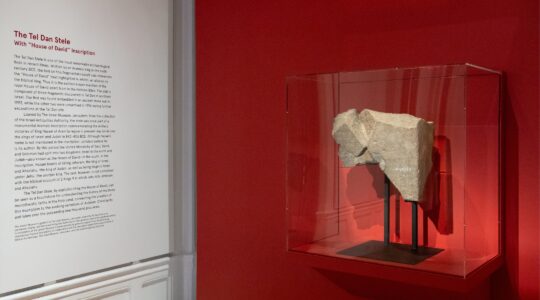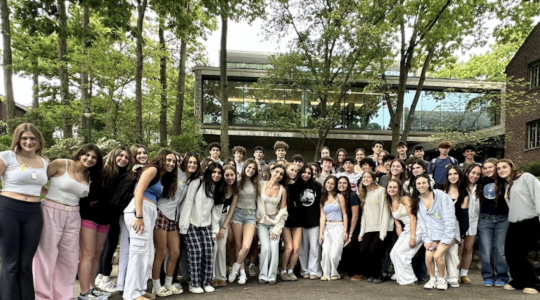Earlier this year, Israeli headlines featured R. Cohen, an Orthodox mother of two who had been separated from her husband Shai for 12 years. Shai chose to spend the last six in jail rather than give his wife a get (writ of Jewish divorce) but now wanted his own freedom. He was taken to a religious court to give the get. During a break in proceedings, unshackled, he escaped by jumping through a second-story men’s room window. Roadblocks and helicopter searches yielded nothing. R. Cohen screamed. She had been so close…
The following day, Sarah, a divorce lawyer for agunot (women waiting for a get), went to the same court with Yael, an agunah of 16 years. Because of the fiasco a day earlier, the judges allowed Yael “a bit of a victory,” Sarah told me. They remanded her husband to jail.
During the past 50 years, there has been much agunah activism around the world: aid organizations, scholarly books, films, prayers, conferences, ostracizing husbands, female advocates in the religious courts, International Agunah Day and more. Prenuptial agreements (to facilitate the giving of a get in event of divorce) are now widely promoted. Civil courts adjudicate cases of iggun (the unresolved situation of an agunah) as matters of civil rights. The Organization for the Resolution of Agunot (ORA) successfully organizes mass rallies against husbands who refuse their wives a get. The very word ORA is enough to scare off some recalcitrant husbands from further mischief
Yet after 50 years, where are we really? We still have agunot in our midst, including newly minted ones. Fear of becoming an agunah has caused countless women to stay in bad marriages or negotiate away financial support and personal property in civil divorce proceedings. And where are we really if we’ve been conditioned to think that incarcerating a husband after 16 years of recalcitrance constitutes “a bit of a victory?”
Prenuptial agreements remain voluntary, and most Orthodox marriages are not covered by get-related pre- or post-nuptial agreements. ORA resolved 200 agunah cases in the past decade, yet 70 new ones are on its docket while it turns away others. And civil courts should not be the venue for solving halachic problems.
Most distressing of all, because the focus is on future prevention and individual case aid, current agunot see the community as running right past them with barely a sideward glance. Cases languish in inhospitable, slow-moving courts; lives are stalled; the frustration, rage and depression of an agunah are endless. Some are suicidal.
Why does iggun exist? Because the principle of a husband’s “absolute right” to control the end of marriage has accompanied Jewish divorce down through the ages. The Mishnah [Yevamot 14:1] states: “A woman is divorced irrespective of her will but a man divorces solely at will.” This rabbinic principle was derived from Deuteronomy 24:1 — “If a man takes a wife who becomes displeasing to him… he writes her a writ of divorce, places it in her hand and sends her away.”
As Jewish divorce law developed over centuries, it confirmed a man’s “absolute right.” Thus, it became a systemic problem, inherent in the law. Some argue the law is not the problem; the recalcitrant husband is. But we must acknowledge the truth: the principle of a man’s absolute right in divorce, open to abuse and lacking systemic remedy, is absolutely wrong.
Yet, that is not the whole story of Jewish divorce. The writ of divorce, an official document, protected a woman against the humiliation of an irrevocable verbal divorce. It insured that she not be kicked out the door like chattel but accorded some dignity at this painful transition. Thus, the get became both her protection and exposure. Throughout history, the rabbis added numerous ameliorations for wives, including the ketubah (wedding contract) that guaranteed her financial security; rights to initiate divorce; and a community’s coercion of her husband to release her. Recognizing there were extreme situations where obtaining a get was not possible, the rabbis created two systemic solutions that suspended a husband’s absolute right and transferred power to themselves to end the marriage.
One solution was hafka’at kiddushin, rabbinic annulment of the marriage when it failed to meet rabbinic expectations and legal norms. The other was kiddushei ta’ut, mistaken marriage: a ceremony enacted with misleading or missing information is considered as if it never took effect. What constitutes “misleading or missing” information ran the gamut, from a groom’s failure to disclose his impotence or criminal record, to umdenah, in which the rabbis assess what would have been in a woman’s mind 25 years earlier under the chupah. For example, had she known of his potential cruelty in abandoning her 25 years later without a get, she would not have married.
And yet, with all of the safeguards, with two systemic solutions in place, the principle of absolute right continued to play a major role in the unfolding of divorce law. Occasionally, the lenient tradition prevailed as in the Geonic period when annulment was used more liberally. But more often, the strict position of unwavering absolute right outweighed other considerations and leniencies, making wives vulnerable to iggun.
And that is where we are unto this very day. Halachic leadership continues to valorize the principle of absolute right in a variety of ways. More halachic literature today is devoted to defending a husband’s free will than to analyzing systemic solutions that curb it. Establishment rabbinic courts apply kiddushei ta’ut precedents very narrowly, counting a husband’s late-disclosed homosexuality but not his pedophilia, his insanity but not his domestic violence.
Support the New York Jewish Week
Our nonprofit newsroom depends on readers like you. Make a donation now to support independent Jewish journalism in New York.
In the 1990s, Rabbi Emanuel Rackman created the Bet Din for Agunot to free agunot through kiddushei ta’ut where there was no hope of a get. Instead of appreciating the heavy halachic lifting he was doing for them, his Modern Orthodox colleagues publicly discredited his bet din.
In 2006, a major international rabbinic conference was convened in Jerusalem to consider systemic solutions for ending iggun. Yet, the conference was cancelled at zero hour under haredi, or fervently Orthodox, pressure.
More telling has been the recent rabbinic response to the work of British legal scholar Bernard Jackson and his Manchester Aguna Research Unit. Jackson and colleagues examined the work of rabbinic luminaries through the ages. They showed that systemic solutions were grounded in halacha, used in the past and could be invoked now. In 2010, Jackson presented his findings to New York rabbis and rabbinic judges. There was little enthusiasm.
So iggun remains an undeniable injustice. That it has been honed through millennia of Jewish life should not be taken to mean it is a sanctified tradition; it means that the injustice will accompany us into the future until we resolve it.
Do we have a choice? Do we say that a husband’s absolute right, though it inflicts injustice on some, is God’s law and we must do all we can to help but must remain faithful to the law; or can we say that we are called upon to do God’s work of justice and compassion, eliminating iggun now and for all time?
That is the tension in the agunah community today. The few who hold the interpretive keys to divorce law, highly respected rabbinic judges, feel genuine anguish at the suffering of innocent women but claim they can do nothing to amend or reinterpret the law. In a sincere desire to alleviate the plight of agunot without touching Jewish law, they lead the community along paths of public shaming and monetary threats — but not a systemic solution to acute agunah cases.
Yet they know that halachic mechanisms for repair have long existed. They know there is more to eternal law than its immutability. When problems or hardship existed, rabbis of every generation refined Jewish law — through selective interpretation, through fiat (takkanot), loopholes and legal fictions when other avenues were closed. That was the genius of the rabbis who enabled Torah law to adapt to the human condition yet also to increase justice as the Jewish people walked through history.
It is obvious that it will take a much stronger force to enable contemporary halachists to look at the matter in a new way. That force must be the Jewish community. Just as a covenant exists between God and the Jewish people, so a covenant exists between the Jewish people and their spiritual leaders. Explicit principles in the tradition affirm this partnership. The entire structure of halachic interpretation and of responsa literature holds the promise of incorporating communal need. In our generation, if a community sees injustice and does not act, it becomes a bystander. An international agunah meeting, the Tikvah-JOFA Agunah Summit (organized by JOFA and NYU’s Tikvah Center for Law & Jewish Civilization), is being convened next week at NYU Law School for leadership and community to examine systemic halachic solutions together, with total transparency, to confirm their legitimacy and broader use but also to affirm that “our hands are tied” is no longer an answer. If not these systemic solutions, then others must be raised up, solutions that are immediate and comprehensive, until promises of airtight prevention are fulfilled. This is not about convenience, but about justice and the “honor of the Torah.”
At the summit table will be the entire community mix, including scholars of tradition and change, scholars of law and culture, synagogue-state experts, human rights activists, religious feminists, lay leaders and philanthropists; political strategists and the press, and the two core groups — dedicated agunah activists along with rabbis and dayanim [religious judges].
The summit must be the beginning of a sustained campaign, not a one-time rally or conference. In addition to halachic review of the sources, one would hope for a broad mandate to emerge from the summit’s collective of religious and lay leaders. These should include the commitment to concluding all unresolved long-term cases of iggun swiftly and for the courts to declare that every case of iggun is a matter of injustice.
Some will interpret these words as an irreverent screed, but that is a deep misreading. All of these words represent those who continue to believe in the chain of tradition, in halachic authority vested in the rabbis and in a tradition of just laws. We affirm the value and importance of a get; we promote prenuptial agreements and support agunah rallies. We speak of applying systemic solutions only where necessary in extreme cases of recalcitrance. We do not advocate civil marriage or non-traditional ceremonies or the use of invalid witnesses at a wedding who, worst-case scenario, can be later drafted to nullify the marriage ceremony.
What we suggest here is that the community empower the rabbis to do right by women faithful to the tradition, restore fairness to Jewish divorce law, eliminate injustice once and for all, and make themselves worthy of the esteemed title they carry and honored positions they hold. Nothing more.
Support the New York Jewish Week
Our nonprofit newsroom depends on readers like you. Make a donation now to support independent Jewish journalism in New York.
This essay is excerpted from a longer version that can be found at www.thejewishweek.com.
For more information about the Agunah Summit on June 24, please contact tikvah.jofasummit@gmail.com
The New York Jewish Week brings you the stories behind the headlines, keeping you connected to Jewish life in New York. Help sustain the reporting you trust by donating today.




